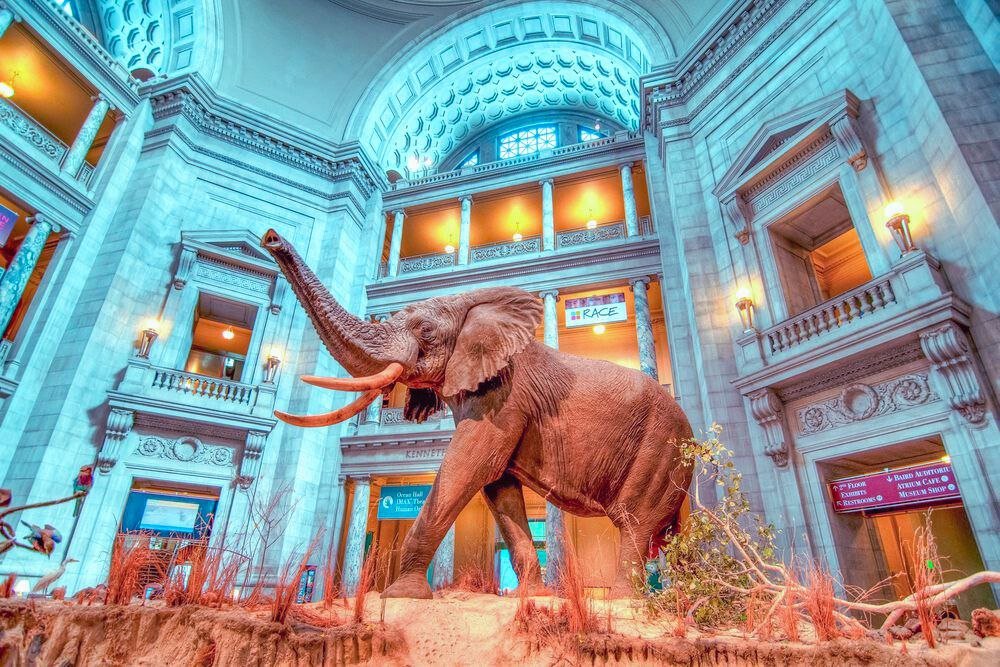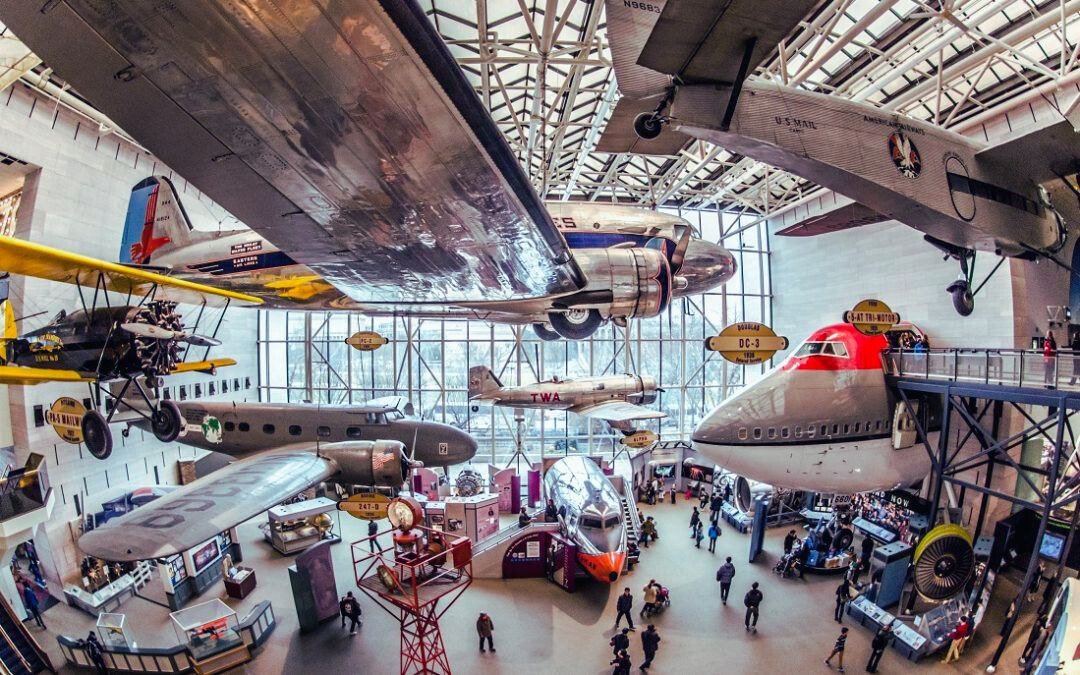Contents


The Smithsonian National Museum of Natural History, situated in the heart of Washington, D.C., stands as a beacon of scientific inquiry and public education. Established in 1910, this venerable institution is one of the most prominent and frequently visited museums globally, drawing millions of visitors each year. As a critical part of the Smithsonian Institution, the museum plays a pivotal role in advancing the understanding and appreciation of the natural world.
Located on the National Mall, the museum’s proximity to other significant landmarks, such as the U.S. Capitol and the Washington Monument, underscores its importance within the cultural and educational landscape of the nation’s capital. The Smithsonian National Museum of Natural History offers a multifaceted experience, blending historical exhibits with cutting-edge research and interactive displays that captivate visitors of all ages.
The museum’s mission is to inspire curiosity and foster a deeper knowledge of the natural world through its vast collections, exhibitions, and research initiatives. Housing over 145 million specimens and artifacts, it encompasses a wide range of disciplines, including anthropology, geology, paleontology, and zoology. This extensive collection serves as a vital resource for scientists and researchers worldwide, facilitating groundbreaking studies and discoveries.
In addition to its impressive collections, the Smithsonian National Museum of Natural History is recognized for its comprehensive educational programs. These initiatives aim to engage the public and encourage lifelong learning, making science accessible and exciting. By offering a variety of workshops, lectures, and hands-on activities, the museum ensures that visitors not only observe but also actively participate in the exploration of natural history.
Overall, the Smithsonian National Museum of Natural History stands as a testament to the enduring human quest for knowledge and understanding. Its rich history, coupled with its commitment to education and research, solidifies its status as a cornerstone of natural history and a must-visit destination for anyone interested in the wonders of the natural world.

Architectural Marvel and Layout
The Smithsonian National Museum of Natural History in Washington, D.C., is a testament to the grandeur of Beaux-Arts architecture, a style renowned for its classical lines and ornate details. This architectural marvel, designed by the prominent firm Hornblower & Marshall, embodies the elegance and grandeur of the early 20th century. At the heart of the museum lies the iconic rotunda, a magnificent space that welcomes visitors with its soaring dome and intricate detailing. The rotunda is not only a visual centerpiece but also a functional hub, guiding visitors to the various sections of the museum.
The museum’s layout is meticulously designed to facilitate an educational and engaging experience for all who walk through its doors. Spanning multiple floors, the museum is organized into several major halls and exhibit areas, each dedicated to different aspects of natural history. The ground floor features the renowned Hall of Mammals, where life-sized dioramas depict mammals in their natural habitats, offering an immersive educational experience. Adjacent to it is the Hall of Human Origins, which traces the evolutionary journey of humankind with interactive exhibits and detailed reconstructions.
Ascending to the upper floors, visitors encounter the Hall of Fossils – Deep Time, a sprawling exhibit that showcases the history of life on Earth through an impressive collection of fossils, including the iconic Tyrannosaurus rex. The Ocean Hall, with its life-sized model of a North Atlantic right whale, provides insights into the diverse marine ecosystems that cover our planet. Each hallway and exhibit space is thoughtfully arranged to create a seamless flow, encouraging exploration and discovery.
The museum’s design emphasizes accessibility and learning, with clear signage, interactive displays, and strategically placed rest areas that enhance the visitor experience. The strategic layout ensures that each exhibit is easily accessible, allowing visitors to navigate the vast collection with ease. This thoughtful design not only showcases the museum’s architectural splendor but also enriches the educational journey, making the Smithsonian National Museum of Natural History a must-visit destination in Washington, D.C.

Permanent Exhibits and Collections
The Smithsonian National Museum of Natural History in Washington, D.C., is home to an array of fascinating permanent exhibits and collections that captivate visitors of all ages. One of the museum’s most prominent attractions is the Hall of Human Origins. This exhibit offers an extensive exploration of human evolution, featuring life-size reconstructions of early human ancestors and interactive displays that delve into the complexities of our development over millions of years. Visitors can gain insights into the biological and cultural milestones that have shaped humanity.
Another significant exhibit is the Sant Ocean Hall, which provides an immersive journey into the depths of the world’s oceans. Highlighting the diversity of marine life, this hall showcases stunning specimens, including a 45-foot-long North Atlantic right whale model and a giant squid. Interactive features and multimedia presentations educate visitors about the intricate ecosystems of the ocean, the importance of marine conservation, and the profound impact of human activities on these environments.
The Butterfly Pavilion is a must-visit for nature enthusiasts. This enchanting exhibit allows visitors to walk among live butterflies from around the world in a lush, tropical setting. It offers a unique opportunity to observe these delicate creatures up close and learn about their life cycles, behaviors, and the critical role they play in pollination and biodiversity.
The David H. Koch Hall of Fossils – Deep Time is another cornerstone of the museum. This exhibit spans 3.7 billion years of life on Earth, featuring an impressive collection of fossils, including a Tyrannosaurus rex and a Triceratops. Through interactive displays and educational programs, visitors can explore the history of life, the processes of evolution, and the environmental changes that have shaped our planet.
Lastly, the Janet Annenberg Hooker Hall of Geology, Gems, and Minerals dazzles with its remarkable collection of geological specimens. Visitors can marvel at the Hope Diamond, one of the world’s most famous gems, and explore a vast array of minerals, meteorites, and precious stones. This exhibit illuminates the wonders of Earth’s geology, the processes that form minerals, and the scientific techniques used to study these natural treasures.
Each of these permanent exhibits offers a wealth of knowledge and an opportunity for visitors to deepen their understanding of the natural world. The Smithsonian National Museum of Natural History remains a beacon of education and discovery, continually inspiring curiosity and appreciation for the planet’s rich heritage.
Special Exhibits and Temporary Displays
The Smithsonian National Museum of Natural History in Washington, D.C., is renowned not only for its permanent collections but also for its dynamic special exhibits and temporary displays. These rotating exhibits offer fresh content that keeps the museum’s offerings engaging for repeat visitors, ensuring that every visit provides a new and enriching experience.
One notable example of a past special exhibit is “The Last American Dinosaurs: Discovering a Lost World,” which showcased the diverse ecosystems and the ultimate extinction of dinosaurs that once roamed North America. This exhibit captivated audiences with its in-depth exploration of paleontological discoveries and was complemented by interactive displays and educational programs.
Another significant temporary display was “Outbreak: Epidemics in a Connected World,” which delved into the science behind infectious diseases and the global impact of pandemics. Aligning closely with current scientific research and contemporary health challenges, this exhibit provided visitors with a timely and relevant understanding of epidemiology and public health.
Temporary displays like “Deep Time” have also played a crucial role in aligning the museum’s offerings with cutting-edge scientific research. This exhibit offered a fascinating journey through Earth’s 4.6 billion-year history, highlighting major evolutionary milestones and geological transformations. By incorporating the latest scientific findings, such exhibits ensure that the museum remains at the forefront of educational outreach.
These special exhibits and temporary displays not only enhance the museum’s appeal but also underscore its commitment to staying relevant and informative. By continuously updating its exhibits to reflect contemporary scientific discoveries, the Smithsonian National Museum of Natural History provides visitors with an ever-evolving experience that fosters a deeper appreciation for the natural world.
Educational Programs and Public Engagement
The Smithsonian National Museum of Natural History in Washington, D.C., is dedicated to fostering a deeper understanding and appreciation of our natural world through a variety of educational programs and public engagement initiatives. The museum offers an array of programs tailored to diverse audiences, ensuring that individuals of all ages and backgrounds can immerse themselves in the wonders of natural history.
For school groups, the museum provides a range of guided tours that align with educational standards, allowing students to explore exhibits while engaging in hands-on learning. These tours are designed to complement classroom curricula and inspire a passion for science among young learners. In addition to guided tours, the museum also offers workshops that delve deeper into specific topics, encouraging critical thinking and interactive participation.
Families visiting the museum can take advantage of family-friendly programs such as interactive storytelling sessions, scavenger hunts, and weekend workshops. These activities are designed to be both educational and entertaining, creating opportunities for family members to learn together and build shared memories. The museum’s commitment to engaging with families extends to its special events, which often feature live demonstrations, craft activities, and guest speakers.
Adults are not left out when it comes to educational opportunities at the Smithsonian National Museum of Natural History. The museum hosts a variety of lectures and panel discussions led by experts in the fields of science and natural history. These events provide a platform for lifelong learners to expand their knowledge and engage in meaningful conversations about current research and discoveries. Additionally, the museum offers adult workshops and courses that cover a wide range of topics, from paleontology to environmental conservation.
The museum’s dedication to public engagement is evident in its interactive exhibits and digital resources. Visitors can engage with exhibits through touchscreens, augmented reality experiences, and virtual tours, making the museum’s vast collections accessible to a global audience. The Smithsonian National Museum of Natural History continually strives to inspire curiosity and a love of science, ensuring that its educational programs and public engagement efforts remain relevant and impactful.
Research and Scientific Contributions
The Smithsonian National Museum of Natural History in Washington, D.C., has long been a cornerstone of scientific research, significantly contributing to the global scientific community. The museum’s scientists are at the forefront of diverse research areas, ranging from anthropology and paleobiology to mineral sciences and entomology. Their work often involves extensive fieldwork across various continents, uncovering new species, and unearthing historical artifacts that provide invaluable insights into our planet’s past.
One of the museum’s most notable contributions is its extensive collection of specimens, which serves as a vital resource for researchers worldwide. Housing over 146 million objects, the collection includes everything from ancient fossils and rare minerals to cultural artifacts and biological specimens. These collections not only support ongoing research but also facilitate new discoveries and advancements in various scientific fields.
Researchers at the museum regularly publish their findings in prestigious scientific journals, contributing to a broader understanding of natural history and its implications for the future. Their studies often address critical issues such as biodiversity loss, climate change, and the impact of human activities on the environment. By disseminating their findings, the museum’s scientists help shape policies and conservation efforts on a global scale.
Moreover, the Smithsonian National Museum of Natural History’s involvement in significant scientific discoveries cannot be overstated. For instance, the museum played a crucial role in the discovery of the “Hobbit” species, Homo floresiensis, in Indonesia. This groundbreaking find has reshaped our understanding of human evolution and highlighted the importance of fieldwork and international collaboration in scientific research.
In addition to fieldwork and publications, the museum fosters scientific inquiry through various programs and initiatives. It collaborates with academic institutions, government agencies, and other research organizations to promote interdisciplinary studies and innovative methodologies. These partnerships not only enhance the museum’s research capabilities but also ensure that its contributions remain relevant and impactful in addressing contemporary scientific challenges.
Visitor Information and Tips
Planning a visit to the Smithsonian National Museum of Natural History in Washington, D.C., involves some essential details to ensure a smooth and enjoyable experience. Located on the National Mall at 10th Street and Constitution Avenue NW, the museum is easily accessible by public transportation. The nearest Metro stations are Federal Triangle and Smithsonian, served by the Blue, Orange, and Silver lines.
The museum is open daily from 10:00 AM to 5:30 PM, with extended hours during peak seasons. It’s important to note that the museum is closed on December 25th. Admission is free, making it a budget-friendly destination for families, students, and tourists alike.
Inside the museum, visitors can find several amenities to enhance their visit. Dining options include the Atrium Café, which offers a variety of meals and snacks, and the Ocean Terrace Café, featuring sustainable seafood dishes. For those looking to take home a memento, the museum has several gift shops offering a range of educational toys, books, and souvenirs.
To make the most of your visit, consider these tips. First, prioritize must-see exhibits such as the iconic Hope Diamond in the Hall of Geology, Gems, and Minerals, the fascinating dinosaur skeletons in the Hall of Fossils, and the awe-inspiring Ocean Hall. Arriving early in the morning or late in the afternoon can help avoid the busiest times, especially on weekends and holidays.
The Smithsonian National Museum of Natural History is also committed to accessibility. The museum provides wheelchairs free of charge on a first-come, first-served basis. All exhibits and public spaces are wheelchair accessible, and there are designated restrooms for visitors with disabilities. For those with hearing impairments, assisted listening devices are available for programs and tours.
By planning ahead and taking advantage of these tips, visitors can ensure a memorable and enriching experience at one of the world’s most renowned natural history museums.
Conclusion and Encouragement to Visit
In exploring the Smithsonian National Museum of Natural History, we have delved into the myriad of exhibits and collections that make this institution a cornerstone of cultural and educational enrichment. From the awe-inspiring fossils in the Dinosaur Hall to the intricate gems and minerals in the Janet Annenberg Hooker Hall, each exhibit is meticulously curated to offer an immersive learning experience. The museum’s dedication to showcasing the diversity of life, both past and present, through its numerous displays, serves as a testament to the vast wonders of the natural world.
The museum’s role extends beyond mere exhibition; it is a beacon of scientific research and education. With its extensive collections, the Smithsonian National Museum of Natural History provides invaluable resources for scientists, researchers, and enthusiasts alike. The institution’s commitment to conservation and sustainability further underscores its importance in promoting environmental awareness and stewardship.
Visiting the Smithsonian National Museum of Natural History is not just an educational journey, but an inspiring adventure that sparks curiosity and a deeper appreciation for our planet. The interactive exhibits, educational programs, and special events ensure that there is something for everyone, regardless of age or background. Whether you are a local resident or a tourist, a solo explorer or a family group, the museum offers a unique opportunity to connect with the natural world in a profound and meaningful way.
We highly encourage you to plan a visit to the Smithsonian National Museum of Natural History. By experiencing its vast collections and engaging exhibits firsthand, you will gain a richer understanding of the natural world and its intricate complexities. The museum stands as a testament to human curiosity and the relentless pursuit of knowledge, making it an essential destination for anyone eager to explore the wonders of our natural history.
OUR SITE: toinewsalert.com
